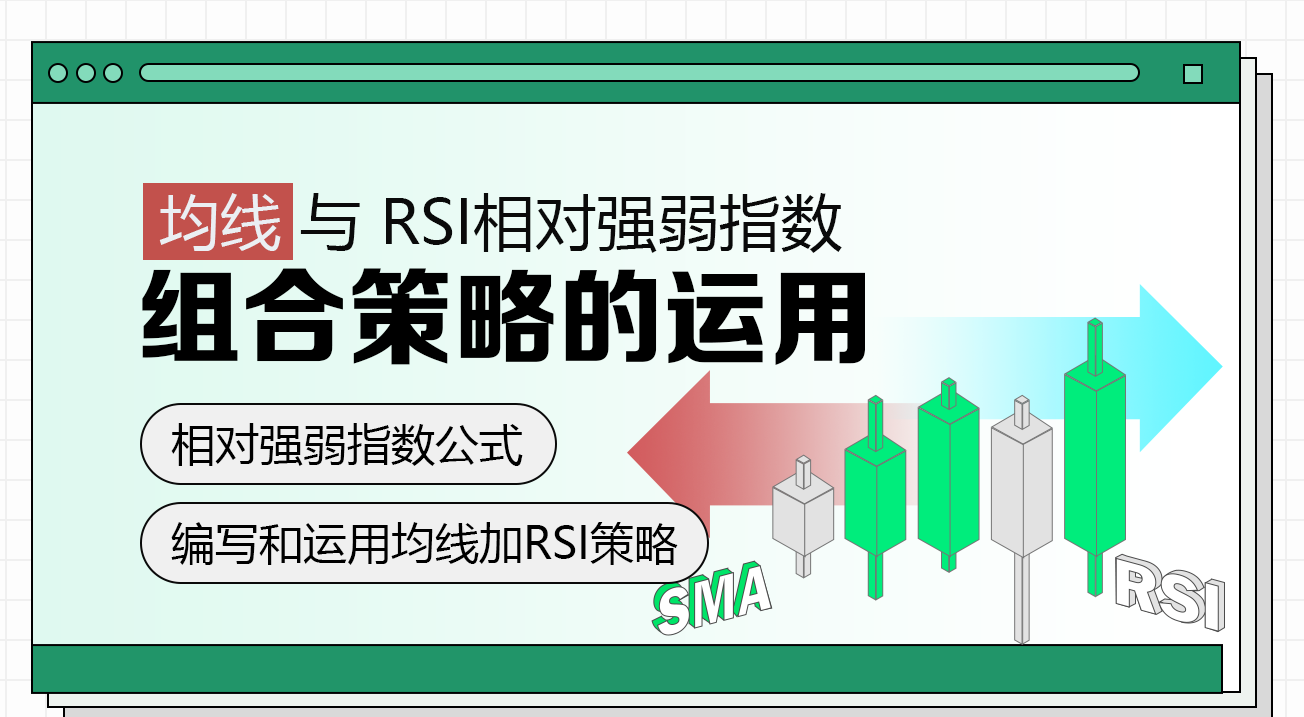The use of a combination strategy for the strength and weakness of the RSI versus the straight line
Author: Goodness, Created: 2019-07-31 14:28:28, Updated: 2024-12-19 21:06:56
Use of the equator in combination with the RSI
As for the horizontal strategy, which has been mentioned many times in previous articles and there are many real-world strategies for you to choose from, the horizontal strategy has always been valued by many CTA strategy enthusiasts due to its great advantage in terms of trend tracking, but for the market, which is still volatile most of the time, it is necessary to add some indicators for fluctuation judgement in combination with trend strategies. This will not only increase potential profitability, but also have great benefits for money management.
In this article, we will introduce one of the most popular oscillators: the Relative Strength and Weakness Index (RSI); you may have read some general articles about the RSI; however, in this article, I will introduce a trading strategy that can be used when trading that can be deployed on inventors' quantified platforms in combination with a straightforward strategy.
Principles and uses of the RSI
Before we delve into the strategy, let's first understand the RSI indicator and give you some basic introductions.
The RSI is one of the most popular indicators on the market.
The RSI is a basic indicator of a trading indicator's performance by comparing the strengths of rising and falling days. The number is calculated and ranges from 0 to 100. A reading above 70 is considered bullish, while a reading below 30 is considered bearish.
Relative strength and weakness index formula
The RSI was developed by J. Welles Wilder and detailed in June 1978 in his book New Concepts of the Silicon Technology Trading System. For all hardcore technical analysts, here is an example of the relative strength index formula.
The RSI is set to 14 days by default, so you can calculate it according to the following formula:
** Relative intensity = 1.25 (average increase over the past 13 K lines) + 0.25 (current increase) / 0.75 (average decrease over the past 13 K lines) + 0 (current decrease))
The relative strength is 1.50 / 0.75 = 2.
RSI = 100 - [100 /(1+2)] = 66.67**
Now that we know the formula for the relative intensity index, let's analyze how to use this powerful indicator.
Most traders use a relatively strong weak index to buy a trade mark only when the indicator reaches 30 and sell at 70, but if you do that, you will buy or sell at a loss according to this rule. The market does not reward anyone for the obvious. This does not mean that the simple approach does not work, but the simple approach followed by everyone has a lower probability.
Writing and implementing equity plus RSI strategies on inventor quantification platforms
Remember, we deployed this strategy to the inventor's quantification platform, and we still chose to program in a simple, easy-to-understand My language.
- Strategy name: Average and RSI relative strength/weakness combined strategy
- Cycle: 15 minutes, 30 minutes, and so on.
- Supported by: Commodity Futures, Digital Currency
The main image:
MA 1, formula: MA1 ^^ EMA (C, N1);
MA 2, formula: MA2 ^^ EMA (C, N2);
This is a sub-graph:
RSI, formula:
RSIVALUE:SMA(MAX(CLOSE-REF(CLOSE,1),0),LENGTH,1)/SMA(ABS(CLOSE-REF(CLOSE,1)),LENGTH,1)*100;

This is a video of the incident.
MA1^^EMA(C,N1);
MA2^^EMA(C,N2);
LENGTH:=9;
OVERBOUGHT:=70;
OVERSOLD:=100-OVERBOUGHT;
RSIVALUE:SMA(MAX(CLOSE-REF(CLOSE,1),0),LENGTH,1)/SMA(ABS(CLOSE-REF(CLOSE,1)),LENGTH,1)*100;
BUYK:=BKVOL=0 AND BARPOS>N2 AND MA1>MA2 AND C>MAX(MA1,MA2) AND CROSSUP(RSIVALUE,OVERBOUGHT);
SELLK:=SKVOL=0 AND BARPOS>N2 AND MA1<MA2 AND C<MIN(MA1,MA2) AND CROSSDOWN(RSIVALUE,OVERSOLD);
SELLY:=MA1<MA2 AND C>BKPRICE*(1+SLOSS*0.01);
BUYY:=MA1>MA2 AND C<SKPRICE*(1-SLOSS*0.01);
SELLS:=C<BKPRICE*(1-SLOSS*0.01);
BUYS:=C>SKPRICE*(1+SLOSS*0.01);
BUYK,BK;
SELLK,SK;
SELLY,SP(BKVOL);
BUYY,BP(SKVOL);
SELLS,SP(BKVOL);
BUYS,BP(SKVOL);
For the source code of the policy, please see:https://www.fmz.com/strategy/128250
- Quantitative Practice of DEX Exchanges (2) -- Hyperliquid User Guide
- DEX exchange quantitative practices ((2) -- Hyperliquid user guide
- Quantitative Practice of DEX Exchanges (1) -- dYdX v4 User Guide
- Introduction to Lead-Lag Arbitrage in Cryptocurrency (3)
- DEX exchange quantitative practice ((1) -- dYdX v4 user guide
- Introduction to the Lead-Lag suite in digital currency (3)
- Introduction to Lead-Lag Arbitrage in Cryptocurrency (2)
- Introduction to the Lead-Lag suite in the digital currency (2)
- Discussion on External Signal Reception of FMZ Platform: A Complete Solution for Receiving Signals with Built-in Http Service in Strategy
- Discussing FMZ platform external signal reception: a complete set of strategies for the reception of signals from built-in HTTP services
- Introduction to Lead-Lag Arbitrage in Cryptocurrency (1)
- Pairing transactions based on data-driven technology
- Quantitative analysis of the digital currency market
- A Dual Thrust digital currency quantified transaction strategy is implemented in Python
- K-line data processing in programmatic transactions is trivial
- Quantitative trading strategies for price dynamics analysis with Python
- Timeline data analysis with Tick data retrieval
- The experience of developing trading strategies
- Calculation and application of DMI indicators
- Detailed usage and practical skills of energy tide(OBV) indicator in quantitative trading
- The development of CTA strategies and the inventor quantification platform standard library
- Upgrade Edition of Keltner Channel trading Strategy
- Neural network and digital currency quantitative trading series ((2)) Deep reinforcement learning training Bitcoin trading strategies
- Implementation and application of the inventor quantified platform in the fall line trading strategy
- Visualizing modules to build trading strategies - out
- KENTNA channel upgraded version of the KENTNA kingkeltner strategy
- Quantitative trading strategies with a trade index weighting
- Introducing the Aroon indicator
- The relative strengths and weaknesses of price-based quantitative trading strategies
- Introducing the adaptive moving average KAMA
- Implementation of Dual Thrust trading algorithms using My language on the inventor's quantification platform